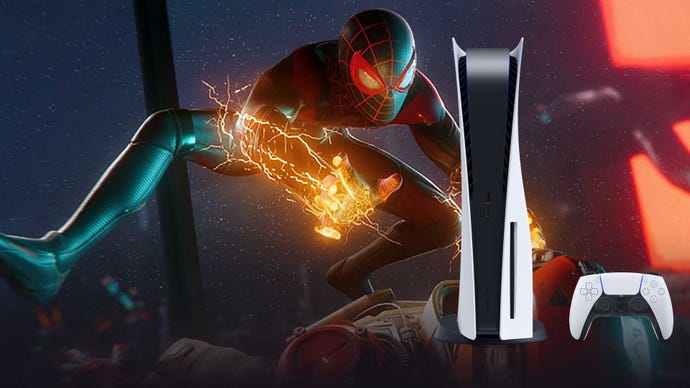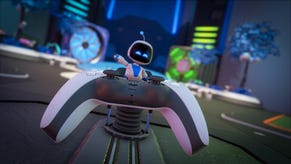PlayStation 5 Initial Impressions: A Huge, Weird Art Mural of a Console
Sony's hefty monolith is finally here.
This article first appeared on USgamer, a partner publication of VG247. Some content, such as this article, has been migrated to VG247 for posterity after USgamer's closure - but it has not been edited or further vetted by the VG247 team.
I remember the first time I turned on the PlayStation 2. After years of oddly-designed boxes for kids—even the black and red Sega Genesis sported that small dome on the top—the PlayStation 2 was all straight lines with a sleek black finish. It looked like a tiny server; it meant business. Combined with the blue discs and that swank blue LED, the PlayStation 2 made a firm statement.
While I enjoy the PlayStation 4 and Xbox One, I admit that I also don't think about them much in terms of the hardware. Since the controllers are wireless and games are increasingly digital, I barely engage with the consoles themselves. Both are clean black boxes that go under my TV, and the only time I mess with them is to blow off the dust in their vents.
The PlayStation 5 is the exact opposite. It's a hulking monolith, a massive system that shouts at you from the moment you pull it out of the box. The sweeping white lines of the shell make the system look like it's melting depending on your perspective, even as the inner blackness of the core system hides the functional buttons and ports from certain angles, prizing subtlety. Sony could have covered the powerful guts of the PS5 in a simple black box, but it seems someone within the company wanted to make a statement. It's one I can hear loud and clear, even if I'm not entirely sure I'm down with what it's saying.
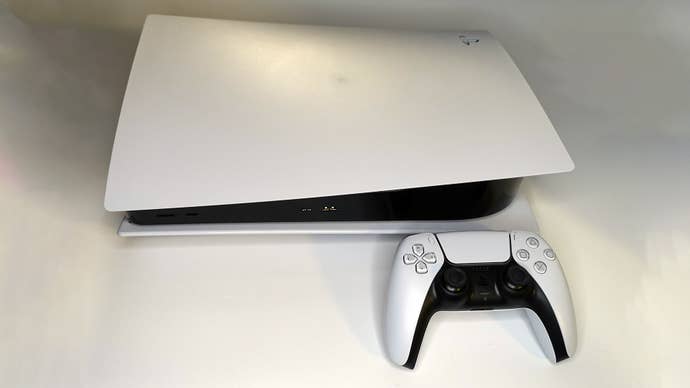
Unboxing the Next Generation
The PlayStation 5 is a hefty monster right out of the box. Picking the box up by the plastic handle, this thing is almost 15 lbs in total. The box is cast in a soft white for the most part, rather than the white and blue of the PS4's box, and at the top it proudly lists labels for 4K120, HDR, and even 8K. Sony and the rest have brand-new 8K televisions for the high-end this year, so they want people to know their shiny console will support them. Pray for developers.
Once you open the box, the immediate inside has the DualSense controllers, the power cable for the system, an HDMI cable, and a USB-C to USB-A cable for charging the DualSense. There's also a Quick Start guide and a Safety guide that most of you won't read. Under those are the system itself, which takes up the rest of the box.
Lift with your knees, not your back, because the PlayStation 5 isn't a small or light system. It weighs 9.81 lbs without the included stand, but since you can't really use the system without the stand, the "real" weight is 10.08 lbs. That's a substantial increase over the PS4 and PS4 Pro, which weighed 6.17 lbs and 7.2 lbs respectively on my scale. The rough dimensions of the thing are 15.4 x 4.1 x 10.2 inches (390 x 104 x 260 mm). I say "rough", because the way the white outer plates frame the system prevents perfectly clean measurements of width, height, and depth. It's not flat by any stretch of the imagination.

The Hardware Design
Someone in the PlayStation 5 design team is taken by modern design. The gentle slopes of the white outer plates remind me of post-modern architecture, like the Heydar Aliyev Center, the Bosjes Chapel, or the Hannam-Dong Hands Corporation Headquarters. It's less about pure functionality and more about evoking some sense of emotion. I'd hazard the feeling is supposed to be "openness", given the way that the system looks like it's opening up in the upright position, becoming wide as you move from the bottom buttons to the air vents.
The PS5 is a system that was obviously designed to stand upright. Not only is that what is shown on the box itself, but the stand further points to this conclusion. In the upright mode, the system sits in the divot of the stand, and a screw is used to affix it to the system. Setting it down on a table, I'm a bit dismayed by the form factor. In the horizontal position, the system just sort of… sits on the stand itself. Without the stand, the system wobbles. On the rear of the lower plate in the horizontal position, there's a pattern of PlayStation symbols to let you know where to hook the stand, but nothing actually attaches it to the system. If you move it forward a bit, sometimes the stand will just fall off. I would've preferred that the system be able to lay flat, or have another spot to screw in the stand when horizontal.
The outer plates nestle the system like a reverse Oreo. On the outside, these plates are soft matte plastic, which seems to attract cat hair in my apartment. The top plate has the PlayStation logo carved out of it on the upper end, while the bottom has a slot for the disc drive. On the inside, each plate also has a slightly bumpy texture that you can only notice if you look close or brush your handle over it.






The inner part of the system is cast in a shiny black plastic similar to the top section of the original PS4 (pictured above), which will absolutely 100% get marked up with fingerprints in most households. I pulled it out for a few minutes and that was enough time to leave a number of marks on the surface. On the bottom of this section (assuming the upright position) are the Power and Eject buttons, which again sort of blend into the face of the PS5 from certain angles. Two inches above them are a USB-C (USB 3.2 Gen 2, SuperSpeed 10Gbps) and USB-A port (Hi-Speed), with the latter being used for the DualSense.
The rear of the PlayStation 5 is all vents and ports, all the time. The entire back is just the textured vents, marked off by a center strip with two USB-A (USB 3.2 Gen 2, SuperSpeed 10Gbps) ports, a LAN port, an HDMI Out port, and the power port. The power supply is inside the system itself, given the cable without the huge attached brick.
On my entertainment stand, the PlayStation 5 sticks out. It doesn't just look like my set top box, PlayStation 4, or Xbox One. In the same way that the Switch's neon Joy-Con colors means it's loud and proud even in the dock, the PS5 calls attention to itself, both in sheer size and design. It's a testament to the power of both next-gen consoles that we've essentially come back around to them being PCs. Hell, at 15.4 inches, the PlayStation is almost as tall as my desktop PC (18.6 inches). I'd hazard the PS5 might not fit into every entertainment stand, and you want to give it space to vent all the heat.


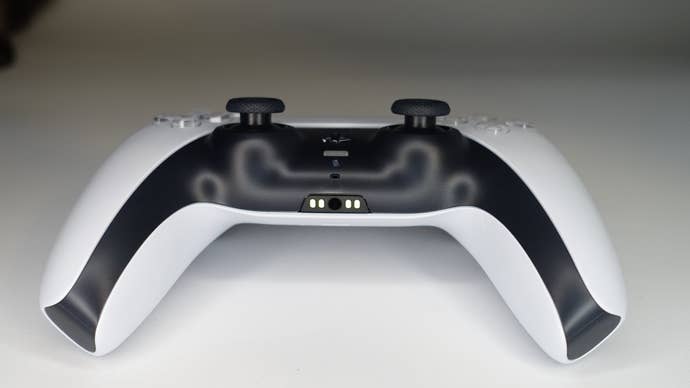
The DualSense Design
The DualSense is the new standard controller for the PlayStation 5, but it's actually seen a good deal of changes compared to the shift from the DualShock 3 to DualShock 4. Instead of the clean black of its predecessor, the DualSense is in two-toned white and black like the system. Button and analog stick replacement is largely the same, though there have been some small changes. The buttons and directional pad are made of smooth clear plastic, with the distinct colors of the Square, Triangle, Square, and Cross buttons being completely gone now. There is a little more 'snap' to the face buttons compared to the muddier face buttons on the DualShock 4.
The LED lightning denoting controller connections has moved under the touchpad, glowing out of either side of it when activated. Where the DualShock 4's Lightbar was, there's now a simple USB-C port. The Ext port on the bottom of the controller is gone completely, and the headphone jack is joined by connectors for the charging cradle. The analog sticks have dropped the slight bumpiness of the DualShock 4 tops in favor of a raised crosshatch texture, somewhat similar to later Xbox One controllers. The triggers and bumpers are actually larger on the DualSense, and the L1 and R1 bumpers have some click to them, making them feel far more satisfying compared to those on the DualShock 4.
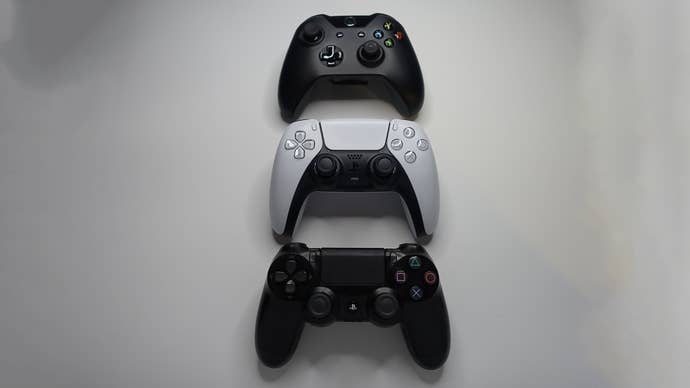
In the hand, it actually feels a bit closer to the Xbox One controller overall. The general shape splits the difference between the DualShock 4 and the Xbox One pad. There's a raised texture for each of the controller's arms—the texture is tiny PlayStation symbols upon closer inspection—that helps immensely with grip. I've gotten used to the Xbox controller as my main gaming option on PC, so I actually like that Sony has moved a bit closer to that design without losing what makes its controllers unique.
One thing hasn't changed though: the DualSense still has a fully internal battery. I prefer the replaceable AA batteries on my Xbox One controller, but at the same time, my original DualShock saw the analog sticks wear out long before they ever stopped taking a charge, so the internal battery isn't really a problem overall.

The DualSense Experience - Astro's Playroom
I'm not allowed to talk about the PlayStation 5 software experience right now, or even tell you what the system is like where it's turned on. That said, Sony did say we could relate the experience of using the DualSense on one game: Astro's Playroom. This title comes loaded on every PS5, and it's meant to give you an idea of how the DualSense performs. Think of the Playroom from the PS4's launch rather than the more robust Astro Bot Rescue Mission that came five years later.
The thrust of Astro's Playroom is guiding Astro through colorful worlds celebrating PlayStation history. Not only will you collect items like the PlayStation 3 system and PlayStation Move controller, you'll also see Astro Bot versions of classic franchises like God of War and Resident Evil. What's important is that Team Asobi showing off the precise feedback on the new haptics in the DualSense.
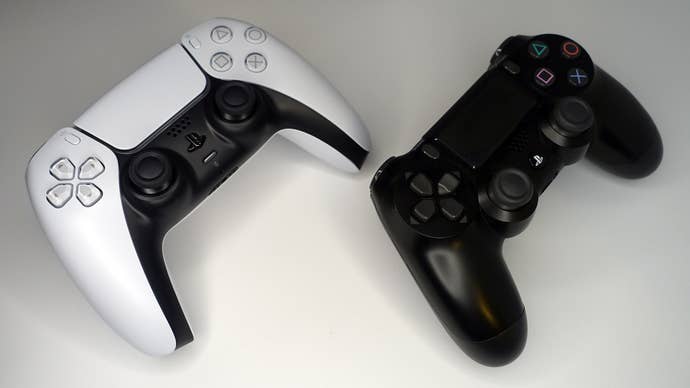
You can feel the pitter patter of Astro's feet on the sand of Cooling Springs' opening beach, an effect enhanced by the slight sound of sand coming over the speaker. The same is true later on when Astro skates over ice, which feels like a faint, smooth movement gliding over the controller. It's also clear there's far more in terms of positioning in regards to the rumble actuators: when Astro is staring face first into a sandstorm whipped up by a fan, you'll feel the rumble in the front of the controller, as opposed to the entire controller. The directional nature is also felt when using the touch pad, as Team Asobi aligned the haptic feedback with the direction your finger is moving on the pad.
In Astro's Playroom the haptic feedback is used more as a showcase, so I'm looking forward to seeing it integrated into other titles like Spider-Man: Miles Morales. Also, it's a really cool effect, and I'm sure that Sony and its first-party studios will put it to excellent use, but I do wonder if it's something that will extend to third-party titles in the future. Is Ubisoft going to work hard on tuning the improved haptics for the PS5, for example? We'll see.
Even more impressive to me are the adaptive triggers. These replace the older triggers on the DualShock 4 and allow the controller to push back on you as needed. In the early part of Astro's Playroom, this is used for greater resistance as a trigger bottoms out, giving the full trigger pull a ton of weight. I can see this being used to great effect when pulling back on a bowstring in Horizon Forbidden West, or perhaps a strong amount of resistance when breaking in Gran Turismo 7. Combined with the improved haptics, I think Sony and company can do some fantastic things with the DualSense in regards to player immersion. Ultimately, developer support is the key here; the touch pad has always been available on the DualShock 4, but not a ton of third-party developers have actually used it for their games.
This is unfortunately where my impressions have to come to an end. This slow unveiling of my thoughts and feelings on the PlayStation 5 are coming over time, just like Sony's own unveiling of the system's capabilities. (Though over a much shorter window.) I ultimately walked away from these early hours feeling a little mixed on the overall design of the console, though I certainly appreciated its unique aesthetic. I'm admittedly a little muted on the promises of the DualSense, but Team Asobi has crafted an excellent showcase of what the controller can do. Will it ultimately do that on a regular basis? Well, depends on how committed developers are to Sony's platform, I think.
All in all, it's clear the next generation is here, and new trends and ideas are on the way. I'm absolutely excited to see what kind of fantastic art will be created using the weird, unique canvas of the PS5.
